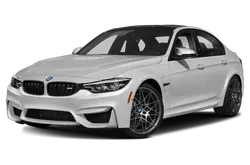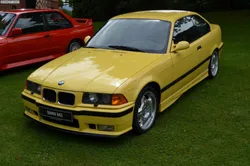

BMW M3 Generation 2 E36 Overview
Explore the BMW M3 Generation 2 E36, a classic performance car featuring timeless design and exhilarating power, capturing the essence of driving in Portugal.
The BMW M3 is synonymous with performance, luxury, and driving pleasure, and the E36 generation, produced between 1992 and 1999, stands as a significant milestone in the history of the M3 series. Known for its striking...
Technical Specifications
Select Version
Dimensions
Engine
Driving
Others
History and Features
Mycarro AI
Apr 26, 2025
The BMW M3 is synonymous with performance, luxury, and driving pleasure, and the E36 generation, produced between 1992 and 1999, stands as a significant milestone in the history of the M3 series. Known for its striking aesthetics, advanced engineering, and dynamic capability, the E36 M3 is often praised for blending everyday usability with track-ready performance. This article explores the highlights of the E36 M3, showcasing its development, characteristics, and legacy.
Development and Design
The E36 M3 was the second generation of the BMW M3 series and was designed to be more refined than its predecessor, the E30. The engineers aimed to create a vehicle that appealed to a broader audience while retaining the sporting essence that enthusiasts had come to expect. A more aerodynamic design characterized the E36, featuring a sleeker profile and larger dimensions than the E30. This change resulted in improved stability and handling, contributing to the vehicle's enhanced performance capabilities.
The E36 M3 was also the first to offer a coupe variant, alongside the sedan. This strategy expanded the M3's appeal, catering to both performance-minded individuals and those seeking a stylish and elegant coupe. The M3's design incorporated wider wheel arches, a more aggressive front fascia, and a distinct rear spoiler, setting it apart from the standard 3 Series models.
Engine and Performance
Under the hood, the E36 M3 introduced the S50 engine, a high-revving, inline-six powerplant that provided exhilarating performance. With a displacement of 3.0 liters, the early versions produced 282 horsepower, while later iterations, including the E36/2 and E36/3 models, featured a 3.2-liter engine, known as the S52, that generated upwards of 320 horsepower. This increase in power provided the E36 M3 with impressive acceleration, capable of reaching 0-60 mph in just over six seconds.
With a near-perfect weight distribution and a sophisticated suspension setup featuring a double-wishbone front and a multi-link rear, the E36 M3 delivered a precise and responsive driving experience. The handling was sharp and agile, making the car a favorite among both casual drivers and track enthusiasts. Moreover, the E36 benefited from advancements in technology, with the option for BMW's Stability Control system, providing drivers with confidence in various driving conditions.
Interior and Features
Inside the cabin, the E36 M3 combined sportiness and luxury. The car featured racing-style bucket seats, a driver-focused dashboard, and high-quality materials that elevated the overall experience. Unlike some of its competitors, the E36 M3 was not only about raw performance; it offered the comfort and convenience expected from a premium brand. Features like power windows, air conditioning, and a premium sound system were available, making the ride enjoyable for both daily commutes and weekend adventures.
One of the notable aspects of the E36 was its accessibility. The car was designed with user-friendly controls and customizable options, allowing drivers to tailor their driving experience. This attention to detail contributed to the vehicle's popularity and accessibility for a more extensive range of drivers, not just hard-core enthusiasts.
Legacy and Impact
The E36 M3 is often viewed as a pivotal model in the M3 lineage, creating a lasting impact within the sports car community. Its blend of performance and practicality garnered a dedicated following, and it played a crucial role in solidifying the M3's reputation as a high-performance sports sedan. As the automotive landscape evolved, so did the E36 M3, paving the way for subsequent generations.
Today, the E36 M3 is regarded as a classic, with many enthusiasts preserving or restoring these vehicles, noting their unique balance of performance, comfort, and everyday drivability. The legacy of the E36 M3 continues to influence BMW's design philosophy and performance benchmarks, and it remains an iconic representation of the M3 heritage.
Conclusion
In conclusion, the BMW M3 E36 generation represents an important chapter in the story of performance automobiles. Through its innovative design, powerful engine options, and a commitment to both luxury and functionality, the E36 ultimately redefined what a sports car could be. Its enduring popularity and cult following highlight the timeless appeal of the E36 M3, ensuring that it will always hold a special place in the hearts of automotive enthusiasts around the world. This blend of elegance and raw power truly encapsulates the spirit of the BMW M3, making the E36 a worthy representative of its lineage.
